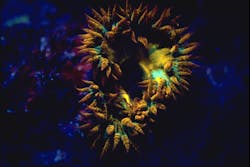Blue light gives night diving a bright makeover
Seeking to get a more vibrant, varied fluorescence experience when viewing marine life during nighttime diving, Charles Mazel, Ph.D., principal research scientist at Physical Sciences Inc. (Andover, MA) and a scuba enthusiast, discovered that blue light delivered.
In the mid-1980s, Mazel experimented with ultraviolet (UV) light, which, while invisible to the human eye, can make marine life fluoresce. He later gained access to a spectrofluorometer, which enabled him to monitor the emission spectra of coral samples, and found that fluorescence was stronger in the blue wavelength region (450–495 nm) than in the UV. Discovering too that blue light caused back reflection that overpowers the beauty of the fluorescence, he remedied that with a yellow filter visor.
In preparation for a diving trip in the Bahamas, he built a blue light prototype using a low-powered filament bulb flashlight. There, he compared his prototype (while wearing his yellow filter visor) with the UV light that he had been using, and found that the blue light/yellow filter combo enabled him to view weak red fluorescence in chlorophyll that cannot be seen using UV light.1
While on another diving trip in Bonaire, Dutch Antilles, Mazel viewed nudibranchs (known as sea slugs), a type of mollusk that sheds its shell after the larval stage and measures around three-quarters of an inch. Nudibranchs may have several utilities in medicine, as scientists have studied their simple nervous systems for clues on learning and memory, and used their defensive toxins in search of pharmaceuticals.2 Mazel was able to view a species of nudibranchs that normally looks translucent, but when illuminated with blue light appear in bright-orange fluorescence, he told BioOptics World.
Mazel's discoveries led him to start NIGHTSEA (Bedford, MA), a company that offers blue-light tools at varying price points for sport divers, researchers, and photographers, among others. In a collaboration with underwater lighting maker Light & Motion (Monterey, CA), Mazel developed the Sola NIGHTSEA blue-light underwater device, which delivers 3000 mW of radiant flux for just under two hours when submerged. A custom interference filter pops on over the light head to convert the blue light to white.
In November 2013, the partners launched the GoBe light tool, which weighs 120 g and is compatible with six interchangeable light heads—including a 500-lumen NIGHTSEA light head with a 20° beam angle and submergibility to 120 m. For more information, please visit http://www.lightandmotion.com/gobe.
1. See http://www.nightsea.com/articles/blue-light-for-underwater-fluorescence/.
2. See http://www.calacademy.org/newsroom/releases/2010/johnson_award.php.

Lee Dubay | Managing Editor
Lee Dubay is managing editor for Laser Focus World. She is a seasoned editor and content manager with 20 years of experience in B2B media. She specializes in digital/print content management, as well as website analytics, SEO, and social media engagement best practices.
